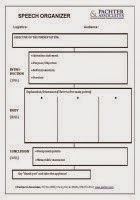My speech went over time. They hated me!
I panicked when I was told to add 20 minutes to my talk!
There seem to be two major concerns:
• How do you correctly calculate how long your talk will take? Many people misjudge their timing, and either go over their allotted time, or run out of things to say.
• How do you quickly adjust the length of your talk? What do you do if you are told, shortly before you are to begin, that you have either more time, or less, than you had anticipated?
Here are four suggestions that can help you address the problems of timing:
1. Prepare properly. If you have prepared what you want to say, you are less likely to ramble, which adds additional time to your talk, and you are less likely to forget material, which would shorten your presentation. In my training classes, participants use my Speech Organizer, which provides a visual representation of the parts of a speech, to structure their presentations and plan what they want to say.

2. Time yourself. Practice giving your presentation so you will know how much time your talk will take. Make it realistic. This needs to be done a couple of times so that you become comfortable with your material and your pacing. Timing your talk won’t be helpful if you are racing through it or stumbling over sections during your presentation.
3. Know what to add or delete. Part of your preparation is anticipating time concerns, and knowing what material you can easily add to or eliminate from your talk. To add extra material, have at the ready additional research, statistics or stories that highlight your key points. The opposite approach is effective when you need to shorten your remarks. Know ahead of time what material is not crucial for your key points, and don’t discuss those items. Speaking faster is not a substitute for the elimination of material.
4. Get a signal. Arrange to have someone in your audience give you an unobtrusive signal to alert you that you have only a certain amount of time left.
If you like this post, check out the highly-acclaimed book, The Essentials of Business Etiquette: How to Greet, Eat, and Tweet Your Way to Success (McGraw Hill). Additional information on presentation skills, effective communication, and etiquette can be found in this book.
Pachter & Associates provides training and coaching on presentation skills. Contact Joyce Hoff at joyce@pachter.com or 856.751.6141.
--An earlier version of this blog appeared almost two years ago. However, there were so many questions prompted by last week’s blog on presentation skills that I decided to update and reprise this one, which is one of my most popular blogs.

From a reader:
ReplyDeleteBarbara:
I have given presentations all over the US and Canada over the years and can share a real jewel with everyone. Figure out what your normal presentation time per PP slide is and that will help you determine the correct number of PP slides you will need for the time allotted.
Example: I know from experience and my presentation method and speed, that I can divide the total minutes I am allotted for my presentation by 1.62. If I am given one hour to speak, then I will need about 36 - 38 PP slides to fill that hour. Everyone will have a sightly different #, but it is a place to start. Then, when you get the 5 minute notice towards the end of your presentation, you will be able to adjust and finish right on time.
Michael
www.markupandprofit.com
It is quite pretty article. We have the statement of purpose social work which is ready to give you a high quality content base work.
ReplyDeleteburberry sale
ReplyDeletelongchamp soldes
burberry outlet
louis vuitton handbags
cheap air max
birkenstock outlet
nike sneakers
michael kors outlet store
adidas trainers
cheap jordan shoes
170601yueqin